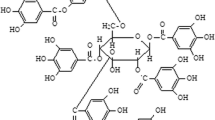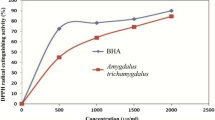Abstract
Scientific data on the ability of the millet phenolic profile in prevention of protein and human erythrocyte peroxidation in terms of their cytoprotective properties is scarce. Catechin, ferulic acid and traces of vanillic acid and resveratrol were identified as bound polyphenols. It was determined that all millet varieties bound phenolics prevented DNA oxidation at a lower concentration of 50 µg. At a concentration of 25 µg kodo millet phenolics retained 80% of proteins visualized in SDS-PAGE. Moreover millet phenolics delayed time response for hemolysis and showed an 88.2% inhibition of erythrocyte lipid peroxidation. Though higher antioxidant property was estimated in kodo millet their bioavailability may be affected since much of the polyphenols occurred in bound form or as condensed tannins. Processed kodo millet with increased bioavailable phenolic content would thus be considered effective compared to other millet varieties for its cytoprotective properties.



Similar content being viewed by others
Abbreviations
- AAPH:
-
2′-Azobis(2-amidinopropane)dihydrochloride
- DPPH:
-
2,2-Diphenyl-1-picrylhydrazyl
- ABTS:
-
2,2′-Azo-bis(3-ethylbenzothiazoline-6-sulphonic acid)
- PC:
-
Proanthocyanidin content
- TFC:
-
Total flavanoid content
- TAC:
-
Total antioxidant capacity
- TEAC:
-
Trolox equivalent antioxidant capacity
- MDA:
-
Malondialdehyde
References
Alias LM, Manoharan S, Vellaichamy L, Balakrishnan S, Ramachandran CR (2009) Protective effect of ferulic acid on 7,12-dimethylbenz[a]anthracene induced skin carcinogenesis in Swiss albino mice. Exp Toxicol Pathol 61:205–214
Carter P (1971) Spectrophotometric determination of serum iron at the submicrogram level with a new reagent (ferrozine). Anal Biochem 40(2):450–458
Chandrasekara A, Naczk M, Shahidi F (2012) Effect of processing on the antioxidant activity of millet grains. Food Chem 133(1):1–9
Eugenio B, Calabrese V, Mancuso C (2009) Ferulic acid and its therapeutic potential as hormetin for age related diseases. Biogerontology 10:97–108
Gorrini C, Harris IS, Mak TW (2013) Modulation of oxidative stress as an anticancer strategy. Nat Rev Drug Discov 12(12):931–947
Goupy P, Hugues M, Boivin P, Amiot MJ (1999) Antioxidant composition and activity of barley (Hordeum vulgare) and malt extracts and of isolated phenolic compounds. J Sci Food Agri 79(12):1625–1634
Gutteridge JM (1995) Lipid peroxidation and antioxidants as biomarkers of tissue damage. Clin Chem 41(12):1819–1828
Hiramoto K, Kido K, Kikugawa K (1994) DNA breaking by Maillard products of glucose-amino acid mixtures formed in an aqueous system. J Agric Food Chem 42(3):689–694
Levine RL, Garland D, Oliver CN, Amici A, Climent I, Lenz AG, Stadtman ER (1990) Determination of carbonyl content in oxidatively modified proteins. Method Enzymol 186:464–478
Liyana-Pathirana CM, Shahidi F (2006) Importance of insoluble-bound phenolics to antioxidant properties of wheat. J Agric Food Chem 54(4):1256–1264
Lutsenko EA, Cárcamo JM, Golde DW (2002) Vitamin C prevents DNA mutation induced by oxidative stress. J Biol Chem 277(19):16895–16899
Mayo JC, Tan DX, Sainz RM, Natarajan M, Lopez-Burillo S, Reiter RJ (2003) Protection against oxidative protein damage induced by metal-catalyzed reaction or alkylperoxyl radicals: comparative effects of melatonin and other antioxidants. Biochim Biophys Acta (BBA)-Gen Subj 1620(1):139–150
Mitjans M, Ugartondo V, Martínez V, Tourino S, Torres JL, Vinardell MP (2011) Role of galloylation and polymerization in cytoprotective effects of polyphenolic fractions against hydrogen peroxide insult. J Agric Food Chem 59(5):2113–2119
Muzhingi T, Yeum KJ, Russell RM, Johnson EJ, Qin J, Tang G (2008) Determination of carotenoids in yellow maize, the effects of saponification and food preparations. Int J Vitam Nutr Res 78(3):112–120
Naidu KA, Thippeswamy NB (2002) Inhibition of human low density lipoprotein oxidation by active principles from spices. Mol Cell Biochem 229(1–2):19–23
Nardini M, D’aquino M, Tomassi G, Gentili V, Di Felice M, Scaccini C (1995) Inhibition of human low-density lipoprotein oxidation by caffeic acid and other hydroxycinnamic acid derivatives. Free Radic Biol Med 19(5):541–552
Oyaizu M (1986) Studies on products of browning reaction–antioxidative activities of products of browning reaction prepared from glucosamine. Jpn J Nutr 44:307–315
Ozturk L, Mansour B, Yuksel M, Yalcin AS, Celikogbrevelu F, Gokhan N (2003) Lipid peroxidation and osmotic fragility of red blood cells in sleep-apnea patients. Clin Chim Acta 332(1):83–88
Palaniswamy SK, Govindaswamy V (2015) Therapeutical properties of ferulic acid and bioavailability enhancement through feruloyl esterase. J Funct Foods 17:657–666
Perron NR, Brumaghim JL (2009) A review of the antioxidant mechanisms of polyphenol compounds related to iron binding. Cell Biochem Biophys 53(2):75–100
Prieto P, Pineda M, Aguilar M (1999) Spectrophotometric quantitation of antioxidant capacity through the formation of a phosphomolybdenum complex: specific application to the determination of vitamin E. Anal Biochem 269(2):337–341
Roy SK (1973) A simple and rapid method of estimation of total carotenoid pigment in mango. J Food Sci Technol 10(1):45–48
Saleh AS, Zhang Q, Chen J, Shen Q (2013) Millet grains: nutritional quality, processing, and potential health benefits. Compr Rev Food Sci F 12(3):281–295
Shacter E (2000) Quantification and significance of protein oxidation in biological samples. Drug Metab Rev 32(3–4):307–326
Singleton VL, Rossi JA (1965) Colorimetry of total phenolics with phosphomolybdic–phosphotungstic acid reagents. Am J Enol Vitic 16(3):144–158
Van Den Berg R, Haenen G, Van Den Berg H, Bast ALT (1999) Applicability of an improved Trolox equivalent antioxidant capacity (TEAC) assay for evaluation of antioxidant capacity measurements of mixtures. Food Chem 66(4):511–517
Wang J, Yuan X, Sun B, Cao Y (2011) Inhibition of lipid peroxidation by enzymatic hydrolysates from wheat bran. Food Technol Biotechnol 49(4):481–487
Wettasinghe M, Shahidi F (2000) Scavenging of reactive oxygen species and DPPH free radicals by extracts of borage and evening primrose. Food Chem 70:17–26
Yang HL, Chen SC, Chang NW, Chang JM, Lee ML, Tsai PC, Hseu YC (2006) Protection from oxidative damage using Bidens pilosa extracts in normal human erythrocytes. Food Chem Toxicol 44(9):1513–1521
Zhao Z, Moghadasian MH (2008) Chemistry, natural sources, dietary intake and pharmacokinetic properties of ferulic acid: a review. Food Chem 109:691–702
Zhishen J, Mengcheng T, Jianming W (1999) The determination of flavonoid contents in mulberry and their scavenging effects on superoxide radicals. Food Chem 64:555–559
Acknowledgements
Sakthi Kumaran thanks CSIR, New Delhi and CSIR-CFTRI, Mysuru, for the award of Junior and Senior Research fellowships. The authors thank Dr. S. Umesh Kumar, Senior Principal Scientist, Microbiology and Fermentation technology Department (CSIR-CFTRI) for suggestions and critical evaluation of the manuscript.
Author information
Authors and Affiliations
Corresponding author
Ethics declarations
Conflict of interest
The authors declare no conflict of interests.
Human and animal studies
This article does not contain any studies with human or animal subjects.
Electronic supplementary material
Below is the link to the electronic supplementary material.
Rights and permissions
About this article
Cite this article
Palaniswamy, S.K., Govindaswamy, V. Inhibition of metal catalyzed H2O2 and peroxyl-AAPH mediated protein, DNA and human erythrocytes lipid oxidation using millet phenolics. J. Plant Biochem. Biotechnol. 26, 406–414 (2017). https://doi.org/10.1007/s13562-017-0401-2
Received:
Accepted:
Published:
Issue Date:
DOI: https://doi.org/10.1007/s13562-017-0401-2




